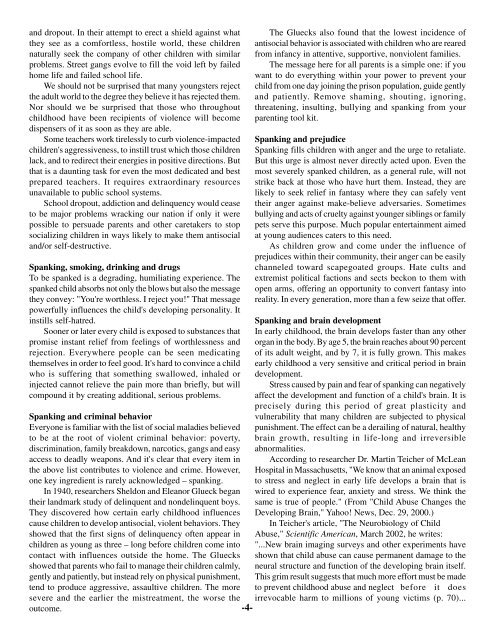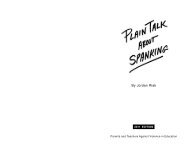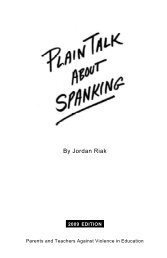Plain Talk about Spanking - Project NoSpank
Plain Talk about Spanking - Project NoSpank
Plain Talk about Spanking - Project NoSpank
Create successful ePaper yourself
Turn your PDF publications into a flip-book with our unique Google optimized e-Paper software.
and dropout. In their attempt to erect a shield against what<br />
they see as a comfortless, hostile world, these children<br />
naturally seek the company of other children with similar<br />
problems. Street gangs evolve to fill the void left by failed<br />
home life and failed school life.<br />
We should not be surprised that many youngsters reject<br />
the adult world to the degree they believe it has rejected them.<br />
Nor should we be surprised that those who throughout<br />
childhood have been recipients of violence will become<br />
dispensers of it as soon as they are able.<br />
Some teachers work tirelessly to curb violence-impacted<br />
children's aggressiveness, to instill trust which those children<br />
lack, and to redirect their energies in positive directions. But<br />
that is a daunting task for even the most dedicated and best<br />
prepared teachers. It requires extraordinary resources<br />
unavailable to public school systems.<br />
School dropout, addiction and delinquency would cease<br />
to be major problems wracking our nation if only it were<br />
possible to persuade parents and other caretakers to stop<br />
socializing children in ways likely to make them antisocial<br />
and/or self-destructive.<br />
<strong>Spanking</strong>, smoking, drinking and drugs<br />
To be spanked is a degrading, humiliating experience. The<br />
spanked child absorbs not only the blows but also the message<br />
they convey: "You're worthless. I reject you!" That message<br />
powerfully influences the child's developing personality. It<br />
instills self-hatred.<br />
Sooner or later every child is exposed to substances that<br />
promise instant relief from feelings of worthlessness and<br />
rejection. Everywhere people can be seen medicating<br />
themselves in order to feel good. It's hard to convince a child<br />
who is suffering that something swallowed, inhaled or<br />
injected cannot relieve the pain more than briefly, but will<br />
compound it by creating additional, serious problems.<br />
<strong>Spanking</strong> and criminal behavior<br />
Everyone is familiar with the list of social maladies believed<br />
to be at the root of violent criminal behavior: poverty,<br />
discrimination, family breakdown, narcotics, gangs and easy<br />
access to deadly weapons. And it's clear that every item in<br />
the above list contributes to violence and crime. However,<br />
one key ingredient is rarely acknowledged – spanking.<br />
In 1940, researchers Sheldon and Eleanor Glueck began<br />
their landmark study of delinquent and nondelinquent boys.<br />
They discovered how certain early childhood influences<br />
cause children to develop antisocial, violent behaviors. They<br />
showed that the first signs of delinquency often appear in<br />
children as young as three – long before children come into<br />
contact with influences outside the home. The Gluecks<br />
showed that parents who fail to manage their children calmly,<br />
gently and patiently, but instead rely on physical punishment,<br />
tend to produce aggressive, assaultive children. The more<br />
severe and the earlier the mistreatment, the worse the<br />
outcome.<br />
-4-<br />
The Gluecks also found that the lowest incidence of<br />
antisocial behavior is associated with children who are reared<br />
from infancy in attentive, supportive, nonviolent families.<br />
The message here for all parents is a simple one: if you<br />
want to do everything within your power to prevent your<br />
child from one day joining the prison population, guide gently<br />
and patiently. Remove shaming, shouting, ignoring,<br />
threatening, insulting, bullying and spanking from your<br />
parenting tool kit.<br />
<strong>Spanking</strong> and prejudice<br />
<strong>Spanking</strong> fills children with anger and the urge to retaliate.<br />
But this urge is almost never directly acted upon. Even the<br />
most severely spanked children, as a general rule, will not<br />
strike back at those who have hurt them. Instead, they are<br />
likely to seek relief in fantasy where they can safely vent<br />
their anger against make-believe adversaries. Sometimes<br />
bullying and acts of cruelty against younger siblings or family<br />
pets serve this purpose. Much popular entertainment aimed<br />
at young audiences caters to this need.<br />
As children grow and come under the influence of<br />
prejudices within their community, their anger can be easily<br />
channeled toward scapegoated groups. Hate cults and<br />
extremist political factions and sects beckon to them with<br />
open arms, offering an opportunity to convert fantasy into<br />
reality. In every generation, more than a few seize that offer.<br />
<strong>Spanking</strong> and brain development<br />
In early childhood, the brain develops faster than any other<br />
organ in the body. By age 5, the brain reaches <strong>about</strong> 90 percent<br />
of its adult weight, and by 7, it is fully grown. This makes<br />
early childhood a very sensitive and critical period in brain<br />
development.<br />
Stress caused by pain and fear of spanking can negatively<br />
affect the development and function of a child's brain. It is<br />
precisely during this period of great plasticity and<br />
vulnerability that many children are subjected to physical<br />
punishment. The effect can be a derailing of natural, healthy<br />
brain growth, resulting in life-long and irreversible<br />
abnormalities.<br />
According to researcher Dr. Martin Teicher of McLean<br />
Hospital in Massachusetts, "We know that an animal exposed<br />
to stress and neglect in early life develops a brain that is<br />
wired to experience fear, anxiety and stress. We think the<br />
same is true of people." (From "Child Abuse Changes the<br />
Developing Brain," Yahoo! News, Dec. 29, 2000.)<br />
In Teicher's article, "The Neurobiology of Child<br />
Abuse," Scientific American, March 2002, he writes:<br />
"...New brain imaging surveys and other experiments have<br />
shown that child abuse can cause permanent damage to the<br />
neural structure and function of the developing brain itself.<br />
This grim result suggests that much more effort must be made<br />
to prevent childhood abuse and neglect before it does<br />
irrevocable harm to millions of young victims (p. 70)...





